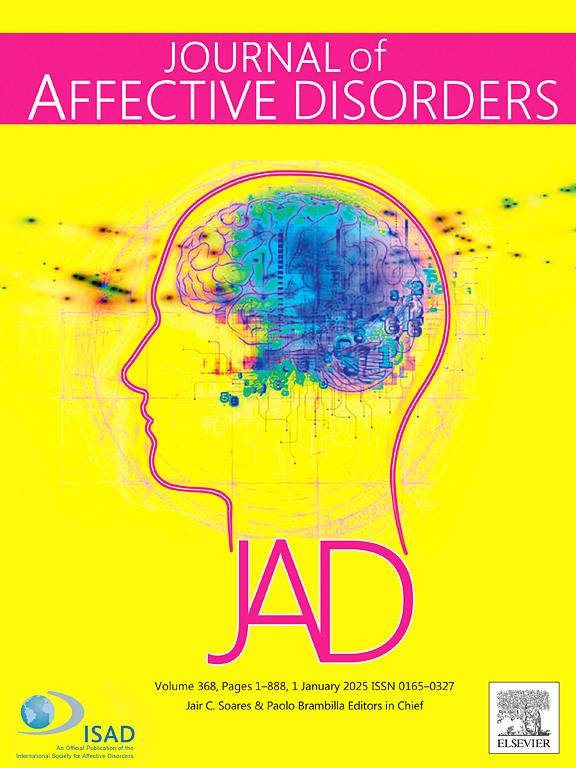一项血浆蛋白质组介导的孟德尔随机研究揭示了类风湿关节炎对欧洲人群精神障碍的影响。
IF 4.9
2区 医学
Q1 CLINICAL NEUROLOGY
引用次数: 0
摘要
目的:本研究旨在评估血浆蛋白质组在类风湿关节炎(RA)和精神障碍之间的潜在介导作用。方法:采用两样本、两步孟德尔随机化(MR)方法研究类风湿关节炎与精神障碍之间的因果关系以及血浆蛋白在这些关联中的作用。进行敏感性分析以验证MR结果。结果:通过MR分析,我们确定了RA亚型(血清阳性RA [SPRA]和血清阴性RA [SNRA])与各种精神障碍(包括双相情感障碍(BD)、焦虑障碍(AD)和囤积障碍(HD))之间的关联。RA与AD呈显著正相关(比值比[OR]: 1.1547;P = 0.0304),SPRA和HD (OR: 1.0138;P = 0.0464),SNRA和BD (OR: 1.0530; = 0.0382页)。蛋白关联分析分别鉴定出167、71和95个血浆蛋白与BD、AD和HD显著相关。经过敏感性测试和错误发现率(FDR)校正,15个蛋白与BD显著相关。中介分析表明EF-hand calcium-binding domain-containing protein 14 (EFCAB14)在SNRA与BD之间的通路中起主要介导作用,占45.8% %,其次是cadherin相关家族成员1 (CDHR1),占23.2% %。结论:本研究强调了类风湿关节炎在精神障碍发展中的重要作用,血浆蛋白在一定程度上介导了这一作用,为未来的诊断生物标志物和干预策略奠定了基础。本文章由计算机程序翻译,如有差异,请以英文原文为准。
A plasma proteome-mediated Mendelian randomization study reveals the impact of rheumatoid arthritis on mental disorders in a European population
Objective
This study aimed to evaluate the potential mediating role of the plasma proteome in the association between rheumatoid arthritis (RA) and mental disorders.
Methods
A two-sample, two-step mediation Mendelian randomization (MR) approach was used to investigate the causal relationship between RA and mental disorders and the role of plasma proteins in these associations. Sensitivity analyses were conducted to validate the MR results.
Results
Through MR analysis, we identified associations between RA subtypes (seropositive RA [SPRA] and seronegative RA [SNRA]) and various mental disorders, including bipolar disorder (BD), anxiety disorder (AD), and hoarding disorder (HD). Significant positive correlations were observed between RA and AD (odds ratio [OR]: 1.1547; P = 0.0304), SPRA and HD (OR: 1.0138; P = 0.0464), and SNRA and BD (OR: 1.0530; P = 0.0382). Protein association analysis identified 167, 71, and 95 plasma proteins significantly associated with BD, AD, and HD, respectively. After sensitivity testing and false discovery rate (FDR) correction, 15 proteins were significantly associated with BD. Mediation analysis indicated that EF-hand calcium-binding domain-containing protein 14 (EFCAB14) played a major mediating role in the pathway between SNRA and BD, accounting for 45.8 % of the effect followed by Cadherin-related family member 1 (CDHR1), which accounted for 23.2 %.
Conclusion
This study highlighted the significant role of RA in mental disorder development, with plasma proteins partially mediating this effect and lays the groundwork for future diagnostic biomarkers and intervention strategies.
求助全文
通过发布文献求助,成功后即可免费获取论文全文。
去求助
来源期刊

Journal of affective disorders
医学-精神病学
CiteScore
10.90
自引率
6.10%
发文量
1319
审稿时长
9.3 weeks
期刊介绍:
The Journal of Affective Disorders publishes papers concerned with affective disorders in the widest sense: depression, mania, mood spectrum, emotions and personality, anxiety and stress. It is interdisciplinary and aims to bring together different approaches for a diverse readership. Top quality papers will be accepted dealing with any aspect of affective disorders, including neuroimaging, cognitive neurosciences, genetics, molecular biology, experimental and clinical neurosciences, pharmacology, neuroimmunoendocrinology, intervention and treatment trials.
 求助内容:
求助内容: 应助结果提醒方式:
应助结果提醒方式:


